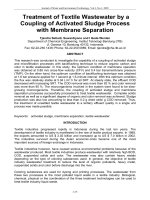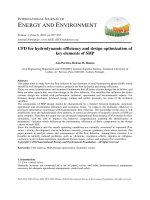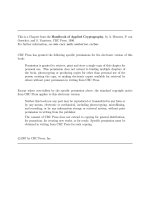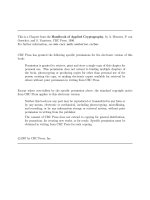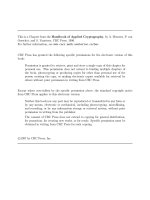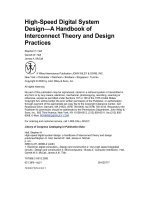- Trang chủ >>
- Khoa Học Tự Nhiên >>
- Vật lý
kuznetsov yu.a. elements of applied bifurcation theory (2ed, springer, 1998)
Bạn đang xem bản rút gọn của tài liệu. Xem và tải ngay bản đầy đủ của tài liệu tại đây (4.36 MB, 614 trang )
Elements of Applied
Bifurcation Theory,
Second Edition
Yuri A. Kuznetsov
SpringerTo my family
This page intentionally left blank
Preface to the Second Edition
The favorable reaction to the first edition of this book confirmed that the
publication of such an application-oriented text on bifurcation theory of
dynamical systems was well timed. The selected topics indeed cover ma-
jor practical issues of applying the bifurcation theory to finite-dimensional
problems. This new edition preserves the structure of the first edition while
updating the context to incorporate recent theoretical developments, in
particular, new and improved numerical methods for bifurcation analysis.
The treatment of some topics has been clarified.
Major additions can be summarized as follows: In Chapter 3, an ele-
mentary proof of the topological equivalence of the original and truncated
normal forms for the fold bifurcation is given. This makes the analysis of
codimension-one equilibrium bifurcations of ODEs in the book complete.
This chapter also includes an example of the Hopf bifurcation analysis in a
planar system using MAPLE, a symbolic manipulation software. Chapter
4 includes a detailed normal form analysis of the Neimark-Sacker bifur-
cation in the delayed logistic map. In Chapter 5, we derive explicit for-
mulas for the critical normal form coefficients of all codim 1 bifurcations
of n-dimensional iterated maps (i.e., fold, flip, and Neimark-Sacker bifur-
cations). The section on homoclinic bifurcations in n-dimensional ODEs
in Chapter 6 is completely rewritten and introduces the Melnikov inte-
gral that allows us to verify the regularity of the manifold splitting under
parameter variations. Recently proved results on the existence of center
manifolds near homoclinic bifurcations are also included. By their means
the study of generic codim 1 homoclinic bifurcations in n-dimensional sys-
tems is reduced to that in some two-, three-, or four-dimensional systems.
viii Preface to the Second Edition
Two- and three-dimensional cases are treated in the main text, while the
analysis of bifurcations in four-dimensional systems with a homoclinic orbit
to a focus-focus is outlined in the new appendix. In Chapter 7, an explicit
example of the “blue sky” bifurcation is discussed. Chapter 10, devoted to
the numerical analysis of bifurcations, has been changed most substantially.
We have introduced bordering methods to continue fold and Hopf bifur-
cations in two parameters. In this approach, the defining function for the
bifurcation used in the minimal augmented system is computed by solving
a bordered linear system. It allows for explicit computation of the gradi-
ent of this function, contrary to the approach when determinants are used
as the defining functions. The main text now includes BVP methods to
continue codim 1 homoclinic bifurcations in two parameters, as well as all
codim 1 limit cycle bifurcations. A new appendix to this chapter provides
test functions to detect all codim 2 homoclinic bifurcations involving a sin-
gle homoclinic orbit to an equilibrium. The software review in Appendix
3 to this chapter is updated to present recently developed programs, in-
cluding AUTO97 with HomCont, DsTool, and CONTENT providing the
information on their availability by ftp.
A number of misprints and minor errors have been corrected while prepar-
ing this edition. I would like to thank many colleagues who have sent
comments and suggestions, including E. Doedel (Concordia University,
Montreal), B. Krauskopf (VU, Amsterdam), S. van Gils (TU Twente, En-
schede), B. Sandstede (WIAS, Berlin), W J. Beyn (Bielefeld University),
F.S. Berezovskaya (Center for Ecological Problems and Forest Productivity,
Moscow), E. Nikolaev and E.E. Shnoll (IMPB, Pushchino, Moscow Region),
W. Langford (University of Guelph), O. Diekmann (Utrecht University),
and A. Champneys (University of Bristol).
I am thankful to my wife, Lioudmila, and to my daughters, Elena and
Ouliana, for their understanding, support, and patience, while I was work-
ing on this book and developing the bifurcation software CONTENT.
Finally, I would like to acknowledge the Research Institute for Applica-
tions of Computer Algebra (RIACA, Eindhoven) for the financial support
of my work at CWI (Amsterdam) in 1995–1997.
Yuri A. Kuznetsov
Amsterdam
September 1997
Preface to the First Edition
During the last few years, several good textbooks on nonlinear dynam-
ics have appeared for graduate students in applied mathematics. It seems,
however, that the majority of such books are still too theoretically ori-
ented and leave many practical issues unclear for people intending to apply
the theory to particular research problems. This book is designed for ad-
vanced undergraduate or graduate students in mathematics who will par-
ticipate in applied research. It is also addressed to professional researchers
in physics, biology, engineering, and economics who use dynamical systems
as modeling tools in their studies. Therefore, only a moderate mathematical
background in geometry, linear algebra, analysis, and differential equations
is required. A brief summary of general mathematical terms and results,
which are assumed to be known in the main text, appears at the end of
the book. Whenever possible, only elementary mathematical tools are used.
For example, we do not try to present normal form theory in full general-
ity, instead developing only the portion of the technique sufficient for our
purposes.
The book aims to provide the student (or researcher) with both a solid
basis in dynamical systems theory and the necessary understanding of the
approaches, methods, results, and terminology used in the modern applied
mathematics literature. A key theme is that of topological equivalence and
codimension, or “what one may expect to occur in the dynamics with a
given number of parameters allowed to vary.” Actually, the material cov-
ered is sufficient to perform quite complex bifurcation analysis of dynam-
ical systems arising in applications. The book examines the basic topics
of bifurcation theory and could be used to compose a course on nonlin-
x Preface to the First Edition
ear dynamical systems or systems theory. Certain classical results, such
as Andronov-Hopf and homoclinic bifurcation in two-dimensional systems,
are presented in great detail, including self-contained proofs. For more com-
plex topics of the theory, such as homoclinic bifurcations in more than two
dimensions and two-parameter local bifurcations, we try to make clear the
relevant geometrical ideas behind the proofs but only sketch them or, some-
times, discuss and illustrate the results but give only references of where
to find the proofs. This approach, we hope, makes the book readable for a
wide audience and keeps it relatively short and able to be browsed. We also
present several recent theoretical results concerning, in particular, bifurca-
tions of homoclinic orbits to nonhyperbolic equilibria and one-parameter
bifurcations of limit cycles in systems with reflectional symmetry. These
results are hardly covered in standard graduate-level textbooks but seem
to be important in applications.
In this book we try to provide the reader with explicit procedures for
application of general mathematical theorems to particular research prob-
lems. Special attention is given to numerical implementation of the devel-
oped techniques. Several examples, mainly from mathematical biology, are
used as illustrations.
The present text originated in a graduate course on nonlinear systems
taught by the author at the Politecnico di Milano in the Spring of 1991. A
similar postgraduate course was given at the Centrum voor Wiskunde en
Informatica (CWI, Amsterdam) in February, 1993. Many of the examples
and approaches used in the book were first presented at the seminars held
at the Research Computing Centre
1
of the Russian Academy of Sciences
(Pushchino, Moscow Region).
Let us briefly characterize the content of each chapter.
Chapter 1. Introduction to dynamical systems. In this chapter we
introduce basic terminology. A dynamical system is defined geometrically
as a family of evolution operators ϕ
t
acting in some state space X and
parametrized by continuous or discrete time t. Some examples, including
symbolic dynamics, are presented. Orbits, phase portraits, and invariant
sets appear before any differential equations, which are treated as one of
the ways to define a dynamical system. The Smale horseshoe is used to illus-
trate the existence of very complex invariant sets having fractal structure.
Stability criteria for the simplest invariant sets (equilibria and periodic or-
bits) are formulated. An example of infinite-dimensional continuous-time
dynamical systems is discussed, namely, reaction-diffusion systems.
Chapter 2. Topological equivalence, bifurcations, and structural
stability of dynamical systems. Two dynamical systems are called topo-
logically equivalent if their phase portraits are homeomorphic. This notion is
1
Renamed in 1992 as the Institute of Mathematical Problems of Biology
(IMPB).
Preface to the First Edition xi
then used to define structurally stable systems and bifurcations. The topo-
logical classification of generic (hyperbolic) equilibria and fixed points of
dynamical systems defined by autonomous ordinary differential equations
(ODEs) and iterated maps is given, and the geometry of the phase portrait
near such points is studied. A bifurcation diagram of a parameter-dependent
system is introduced as a partitioning of its parameter space induced by
the topological equivalence of corresponding phase portraits. We introduce
the notion of codimension (codim for short) in a rather naive way as the
number of conditions defining the bifurcation. Topological normal forms
(universal unfoldings of nondegenerate parameter-dependent systems) for
bifurcations are defined, and an example of such a normal form is demon-
strated for the Hopf bifurcation.
Chapter 3. One-parameter bifurcations of equilibria in continu-
ous-time dynamical systems. Two generic codim 1 bifurcations – tan-
gent (fold) and Andronov-Hopf – are studied in detail following the same
general approach: (1) formulation of the corresponding topological normal
form and analysis of its bifurcations; (2) reduction of a generic parameter-
dependent system to the normal form up to terms of a certain order; and
(3) demonstration that higher-order terms do not affect the local bifur-
cation diagram. Step 2 (finite normalization) is performed by means of
polynomial changes of variables with unknown coefficients that are then
fixed at particular values to simplify the equations. Relevant normal form
and nondegeneracy (genericity) conditions for a bifurcation appear natu-
rally at this step. An example of the Hopf bifurcation in a predator-prey
system is analyzed.
Chapter 4. One-parameter bifurcations of fixed points in discre-
te-time dynamical systems. The approach formulated in Chapter 3 is
applied to study tangent (fold), flip (period-doubling), and Hopf (Neimark-
Sacker) bifurcations of discrete-time dynamical systems. For the Neimark-
Sacker bifurcation, as is known, a normal form so obtained captures only
the appearance of a closed invariant curve but does not describe the orbit
structure on this curve. Feigenbaum’s universality in the cascade of period
doublings is explained geometrically using saddle properties of the period-
doubling map in an appropriate function space.
Chapter 5. Bifurcations of equilibria and periodic orbits in n-
dimensional dynamical systems. This chapter explains how the results
on codim 1 bifurcations from the two previous chapters can be applied to
multidimensional systems. A geometrical construction is presented upon
which a proof of the Center Manifold Theorem is based. Explicit formulas
are derived for the quadratic coefficients of the Taylor approximations to
the center manifold for all codim 1 bifurcations in both continuous and
discrete time. An example is discussed where the linear approximation of
the center manifold leads to the wrong stability analysis of an equilibrium.
We present in detail a projection method for center manifold computation
that avoids the transformation of the system into its eigenbasis. Using this
xii Preface to the First Edition
method, we derive a compact formula to determine the direction of a Hopf
bifurcation in multidimensional systems. Finally, we consider a reaction-
diffusion system on an interval to illustrate the necessary modifications of
the technique to handle the Hopf bifurcation in some infinite-dimensional
systems.
Chapter 6. Bifurcations of orbits homoclinic and heteroclinic
to hyperbolic equilibria. This chapter is devoted to the generation of
periodic orbits via homoclinic bifurcations. A theorem due to Andronov
and Leontovich describing homoclinic bifurcation in planar continuous-time
systems is formulated. A simple proof is given which uses a constructive
C
1
-linearization of a system near its saddle point. All codim 1 bifurcations
of homoclinic orbits to saddle and saddle-focus equilibrium points in three-
dimensional ODEs are then studied. The relevant theorems by Shil’nikov
are formulated together with the main geometrical constructions involved
in their proofs. The role of the orientability of invariant manifolds is em-
phasized. Generalizations to more dimensions are also discussed. An appli-
cation of Shil’nikov’s results to nerve impulse modeling is given.
Chapter 7. Other one-parameter bifurcations in continuous-
time dynamical systems. This chapter treats some bifurcations of ho-
moclinic orbits to nonhyperbolic equilibrium points, including the case of
several homoclinic orbits to a saddle-saddle point, which provides one of
the simplest mechanisms for the generation of an infinite number of peri-
odic orbits. Bifurcations leading to a change in the rotation number on an
invariant torus and some other global bifurcations are also reviewed. All
codim 1 bifurcations of equilibria and limit cycles in Z
2
-symmetric systems
are described together with their normal forms.
Chapter 8. Two-parameter bifurcations of equilibria in conti-
nuous-time dynamical systems. One-dimensional manifolds in the di-
rect product of phase and parameter spaces corresponding to the tangent
and Hopf bifurcations are defined and used to specify all possible codim 2
bifurcations of equilibria in generic continuous-time systems. Topological
normal forms are presented and discussed in detail for the cusp, Bogdanov-
Takens, and generalized Andronov-Hopf (Bautin) bifurcations. An example
of a two-parameter analysis of Bazykin’s predator-prey model is considered
in detail. Approximating symmetric normal forms for zero-Hopf and Hopf-
Hopf bifurcations are derived and studied, and their relationship with the
original problems is discussed. Explicit formulas for the critical normal form
coefficients are given for the majority of the codim 2 cases.
Chapter 9. Two-parameter bifurcations of fixed points in discre-
te-time dynamical systems. A list of all possible codim 2 bifurcations
of fixed points in generic discrete-time systems is presented. Topologi-
cal normal forms are obtained for the cusp and degenerate flip bifurca-
tions with explicit formulas for their coefficients. An approximate normal
form is presented for the Neimark-Sacker bifurcation with cubic degener-
acy (Chenciner bifurcation). Approximating normal forms are expressed
Preface to the First Edition xiii
in terms of continuous-time planar dynamical systems for all strong reso-
nances (1:1, 1:2, 1:3, and 1:4). The Taylor coefficients of these continuous-
time systems are explicitly given in terms of those of the maps in question.
A periodically forced predator-prey model is used to illustrate resonant
phenomena.
Chapter 10. Numerical analysis of bifurcations. This final chapter
deals with numerical analysis of bifurcations, which in most cases is the only
tool to attack real problems. Numerical procedures are presented for the
location and stability analysis of equilibria and the local approximation
of their invariant manifolds as well as methods for the location of limit
cycles (including orthogonal collocation). Several methods are discussed
for equilibrium continuation and detection of codim 1 bifurcations based
on predictor-corrector schemes. Numerical methods for continuation and
analysis of homoclinic bifurcations are also formulated.
Each chapter contains exercises, and we have provided hints for the most
difficult of them. The references and comments to the literature are sum-
marized at the end of each chapter as separate bibliographical notes. The
aim of these notes is mainly to provide a reader with information on fur-
ther reading. The end of a theorem’s proof (or its absence) is marked by
the symbol ✷, while that of a remark (example) is denoted by ♦ (✸),
respectively.
As is clear from this Preface, there are many important issues this book
does not touch. In fact, we study only the first bifurcations on a route to
chaos and try to avoid the detailed treatment of chaotic dynamics, which
requires more sophisticated mathematical tools. We do not consider im-
portant classes of dynamical systems such as Hamiltonian systems (e.g.,
KAM-theory and Melnikov methods are left outside the scope of this book).
Only introductory information is provided on bifurcations in systems with
symmetries. The list of omissions can easily be extended. Nevertheless, we
hope the reader will find the book useful, especially as an interface between
undergraduate and postgraduate studies.
This book would have never appeared without the encouragement and
help from many friends and colleagues to whom I am very much indebted.
The idea of such an application-oriented book on bifurcations emerged in
discussions and joint work with A.M. Molchanov, A.D. Bazykin, E.E. Shnol,
and A.I. Khibnik at the former Research Computing Centre of the USSR
Academy of Sciences (Pushchino). S. Rinaldi asked me to prepare and give a
course on nonlinear systems at the Politecnico di Milano that would be use-
ful for applied scientists and engineers. O. Diekmann (CWI, Amsterdam)
was the first to propose the conversion of these brief lecture notes into a
book. He also commented on some of the chapters and gave friendly sup-
port during the whole project. S. van Gils (TU Twente, Enschede) read the
manuscript and gave some very useful suggestions that allowed me to im-
prove the content and style. I am particularly thankful to A.R. Champneys
xiv Preface to the First Edition
of the University of Bristol, who reviewed the whole text and not only cor-
rected the language but also proposed many improvements in the selection
and presentation of the material. Certain topics have been discussed with J.
Sanders (VU/RIACA/CWI, Amsterdam), B. Werner (University of Ham-
burg), E. Nikolaev (IMPB, Pushchino), E. Doedel (Concordia University,
Montreal), B. Sandstede (IAAS, Berlin), M. Kirkilonis (CWI, Amsterdam),
J. de Vries (CWI, Amsterdam), and others, whom I would like to thank.
Of course, the responsibility for all remaining mistakes is mine. I would
also like to thank A. Heck (CAN, Amsterdam) and V.V. Levitin (IMPB,
Pushchino/CWI, Amsterdam) for computer assistance. Finally, I thank the
Nederlandse Organisatie voor Wetenschappelijk Onderzoek (NWO) for pro-
viding financial support during my stay at CWI, Amsterdam.
Yuri A. Kuznetsov
Amsterdam
December 1994
Contents
Preface to the Second Edition vii
Preface to the First Edition ix
1 Introduction to Dynamical Systems 1
1.1 Definition of a dynamical system 1
1.1.1 State space 2
1.1.2 Time 5
1.1.3 Evolution operator 5
1.1.4 Definition of a dynamical system 7
1.2 Orbits and phase portraits 8
1.3 Invariant sets 11
1.3.1 Definition and types 11
1.3.2 Example 1.9 (Smale horseshoe) 12
1.3.3 Stability of invariant sets 16
1.4 Differential equations and dynamical systems 18
1.5 Poincar´e maps 23
1.5.1 Time-shift maps 24
1.5.2 Poincar´e map and stability of cycles 25
1.5.3 Poincar´e map for periodically forced systems 30
1.6 Exercises 31
1.7 Appendix 1: Infinite-dimensional dynamical systems defined
by reaction-diffusion equations 33
1.8 Appendix 2: Bibliographical notes 37
xvi Preface to the First Edition
2 Topological Equivalence, Bifurcations,
and Structural Stability of Dynamical Systems 39
2.1 Equivalence of dynamical systems 39
2.2 Topological classification of generic equilibria and fixed points 46
2.2.1 Hyperbolic equilibria in continuous-time systems 46
2.2.2 Hyperbolic fixed points in discrete-time systems 49
2.2.3 Hyperbolic limit cycles 54
2.3 Bifurcations and bifurcation diagrams 57
2.4 Topological normal forms for bifurcations 63
2.5 Structural stability 68
2.6 Exercises 73
2.7 Appendix: Bibliographical notes 76
3 One-Parameter Bifurcations of Equilibria
in Continuous-Time Dynamical Systems 79
3.1 Simplest bifurcation conditions 79
3.2 The normal form of the fold bifurcation 80
3.3 Generic fold bifurcation 83
3.4 The normal form of the Hopf bifurcation 86
3.5 Generic Hopf bifurcation 91
3.6 Exercises 104
3.7 Appendix 1: Proof of Lemma 3.2 108
3.8 Appendix 2: Bibliographical notes 111
4 One-Parameter Bifurcations of Fixed Points
in Discrete-Time Dynamical Systems 113
4.1 Simplest bifurcation conditions 113
4.2 The normal form of the fold bifurcation 114
4.3 Generic fold bifurcation 116
4.4 The normal form of the flip bifurcation 119
4.5 Generic flip bifurcation 121
4.6 The “normal form” of the Neimark-Sacker bifurcation 125
4.7 Generic Neimark-Sacker bifurcation 129
4.8 Exercises 138
4.9 Appendix 1: Feigenbaum’s universality 139
4.10 Appendix 2: Proof of Lemma 4.3 143
4.11 Appendix 3: Bibliographical notes 149
5 Bifurcations of Equilibria and Periodic Orbits
in n-Dimensional Dynamical Systems 151
5.1 Center manifold theorems 151
5.1.1 Center manifolds in continuous-time systems 152
5.1.2 Center manifolds in discrete-time systems 156
5.2 Center manifolds in parameter-dependent systems 157
5.3 Bifurcations of limit cycles 162
Preface to the First Edition xvii
5.4 Computation of center manifolds 165
5.4.1 Quadratic approximation to center manifolds
in eigenbasis 165
5.4.2 Projection method for center manifold computation 171
5.5 Exercises 186
5.6 Appendix 1: Hopf bifurcation in reaction-diffusion systems
on the interval with Dirichlet boundary conditions 189
5.7 Appendix 2: Bibliographical notes 193
6 Bifurcations of Orbits Homoclinic and Heteroclinic
to Hyperbolic Equilibria 195
6.1 Homoclinic and heteroclinic orbits 195
6.2 Andronov-Leontovich theorem 200
6.3 Homoclinic bifurcations in three-dimensional systems:
Shil’nikov theorems 213
6.4 Homoclinic bifurcations in n-dimensional systems 228
6.4.1 Regular homoclinic orbits: Melnikov integral 229
6.4.2 Homoclinic center manifolds 232
6.4.3 Generic homoclinic bifurcations in R
n
236
6.5 Exercises 238
6.6 Appendix 1: Focus-focus homoclinic bifurcation
in four-dimensional systems 241
6.7 Appendix 2: Bibliographical notes 247
7 Other One-Parameter Bifurcations
in Continuous-Time Dynamical Systems 249
7.1 Codim 1 bifurcations of homoclinic orbits to nonhyperbolic
equilibria 250
7.1.1 Saddle-node homoclinic bifurcation on the plane 250
7.1.2 Saddle-node and saddle-saddle homoclinic
bifurcations in R
3
253
7.2 “Exotic” bifurcations 262
7.2.1 Nontransversal homoclinic orbit to a hyperbolic cycle 263
7.2.2 Homoclinic orbits to a nonhyperbolic limit cycle 263
7.3 Bifurcations on invariant tori 267
7.3.1 Reduction to a Poincar´e map 267
7.3.2 Rotation number and orbit structure 269
7.3.3 Structural stability and bifurcations 270
7.3.4 Phase locking near a Neimark-Sacker bifurcation:
Arnold tongues 272
7.4 Bifurcations in symmetric systems 276
7.4.1 General properties of symmetric systems 276
7.4.2 Z
2
-equivariant systems 278
7.4.3 Codim 1 bifurcations of equilibria in Z
2
-equivariant
systems 280
xviii Preface to the First Edition
7.4.4 Codim 1 bifurcations of cycles
in Z
2
-equivariant systems 283
7.5 Exercises 288
7.6 Appendix 1: Bibliographical notes 290
8 Two-Parameter Bifurcations of Equilibria
in Continuous-Time Dynamical Systems 293
8.1 List of codim 2 bifurcations of equilibria 294
8.1.1 Codim 1 bifurcation curves 294
8.1.2 Codim 2 bifurcation points 297
8.2 Cusp bifurcation 301
8.2.1 Normal form derivation 301
8.2.2 Bifurcation diagram of the normal form 303
8.2.3 Effect of higher-order terms 305
8.3 Bautin (generalized Hopf) bifurcation 307
8.3.1 Normal form derivation 307
8.3.2 Bifurcation diagram of the normal form 312
8.3.3 Effect of higher-order terms 313
8.4 Bogdanov-Takens (double-zero) bifurcation 314
8.4.1 Normal form derivation 314
8.4.2 Bifurcation diagram of the normal form 321
8.4.3 Effect of higher-order terms 324
8.5 Fold-Hopf (zero-pair) bifurcation 330
8.5.1 Derivation of the normal form 330
8.5.2 Bifurcation diagram of the truncated normal form . 337
8.5.3 Effect of higher-order terms 342
8.6 Hopf-Hopf bifurcation 349
8.6.1 Derivation of the normal form 349
8.6.2 Bifurcation diagram of the truncated normal form . 356
8.6.3 Effect of higher-order terms 366
8.7 Exercises 369
8.8 Appendix 1: Limit cycles and homoclinic orbits of Bogdanov
normal form 382
8.9 Appendix 2: Bibliographical notes 390
9 Two-Parameter Bifurcations of Fixed Points
in Discrete-Time Dynamical Systems 393
9.1 List of codim 2 bifurcations of fixed points 393
9.2 Cusp bifurcation 397
9.3 Generalized flip bifurcation 400
9.4 Chenciner (generalized Neimark-Sacker) bifurcation 404
9.5 Strong resonances 408
9.5.1 Approximation by a flow 408
9.5.2 1:1 resonance 410
9.5.3 1:2 resonance 415
Preface to the First Edition xix
9.5.4 1:3 resonance 428
9.5.5 1:4 resonance 435
9.6 Codim 2 bifurcations of limit cycles 446
9.7 Exercises 457
9.8 Appendix 1: Bibliographical notes 460
10 Numerical Analysis of Bifurcations 463
10.1 Numerical analysis at fixed parameter values 464
10.1.1 Equilibrium location 464
10.1.2 Modified Newton’s methods 466
10.1.3 Equilibrium analysis 469
10.1.4 Location of limit cycles 472
10.2 One-parameter bifurcation analysis 478
10.2.1 Continuation of equilibria and cycles 479
10.2.2 Detection and location of codim 1 bifurcations 484
10.2.3 Analysis of codim 1 bifurcations 488
10.2.4 Branching points 495
10.3 Two-parameter bifurcation analysis 501
10.3.1 Continuation of codim 1 bifurcations of equilibria
and fixed points 501
10.3.2 Continuation of codim 1 limit cycle bifurcations 507
10.3.3 Continuation of codim 1 homoclinic orbits 510
10.3.4 Detection and location of codim 2 bifurcations 514
10.4 Continuation strategy 515
10.5 Exercises 517
10.6 Appendix 1: Convergence theorems for Newton methods 525
10.7 Appendix 2: Detection of codim 2 homoclinic bifurcations . 526
10.7.1 Singularities detectable via eigenvalues 527
10.7.2 Orbit and inclination flips 529
10.7.3 Singularities along saddle-node homoclinic curves 534
10.8 Appendix 3: Bibliographical notes 535
A Basic Notions from Algebra, Analysis, and Geometry 541
A.1 Algebra 541
A.1.1 Matrices 541
A.1.2 Vector spaces and linear transformations 543
A.1.3 Eigenvectors and eigenvalues 544
A.1.4 Invariant subspaces, generalized eigenvectors,
and Jordan normal form 545
A.1.5 Fredholm Alternative Theorem 546
A.1.6 Groups 546
A.2 Analysis 547
A.2.1 Implicit and Inverse Function Theorems 547
A.2.2 Taylor expansion 548
A.2.3 Metric, normed, and other spaces 549
xx Preface to the First Edition
A.3 Geometry 550
A.3.1 Sets 550
A.3.2 Maps 551
A.3.3 Manifolds 551
References 553
Index 577
1
Introduction to Dynamical Systems
This chapter introduces some basic terminology. First, we define a dynam-
ical system and give several examples, including symbolic dynamics. Then
we introduce the notions of orbits, invariant sets, and their stability.As
we shall see while analyzing the Smale horseshoe, invariant sets can have
very complex structures. This is closely related to the fact discovered in
the 1960s that rather simple dynamical systems may behave “randomly,”
or “chaotically.” Finally, we discuss how differential equations can define
dynamical systems in both finite- and infinite-dimensional spaces.
1.1 Definition of a dynamical system
The notion of a dynamical system is the mathematical formalization of the
general scientific concept of a deterministic process. The future and past
states of many physical, chemical, biological, ecological, economical, and
even social systems can be predicted to a certain extent by knowing their
present state and the laws governing their evolution. Provided these laws
do not change in time, the behavior of such a system could be considered
as completely defined by its initial state. Thus, the notion of a dynamical
system includes a set of its possible states (state space) and a law of the
evolution of the state in time. Let us discuss these ingredients separately
and then give a formal definition of a dynamical system.
2 1. Introduction to Dynamical Systems
ϕ
l
.
m
ϕ
FIGURE 1.1. Classical pendulum.
1.1.1 State space
All possible states of a system are characterized by the points of some set X.
This set is called the state space of the system. Actually, the specification of
a point x ∈ X must be sufficient not only to describe the current “position”
of the system but also to determine its evolution. Different branches of
science provide us with appropriate state spaces. Often, the state space is
called a phase space, following a tradition from classical mechanics.
Example 1.1 (Pendulum) The state of an ideal pendulum is com-
pletely characterized by defining its angular displacement ϕ (mod 2π) from
the vertical position and the corresponding angular velocity ˙ϕ (see Figure
1.1). Notice that the angle ϕ alone is insufficient to determine the future
state of the pendulum. Therefore, for this simple mechanical system, the
state space is X = S
1
×R
1
, where S
1
is the unit circle parametrized by the
angle, and R
1
is the real axis corresponding to the set of all possible veloc-
ities. The set X can be considered as a smooth two-dimensional manifold
(cylinder) in R
3
. ✸
Example 1.2 (General mechanical system) In classical mechanics,
the state of an isolated system with s degrees of freedom is characterized
bya2s-dimensional real vector:
(q
1
,q
2
, ,q
s
,p
1
,p
2
, ,p
s
)
T
,
where q
i
are the generalized coordinates, while p
i
are the corresponding
generalized momenta. Therefore, in this case, X = R
2s
.Ifk coordinates are
cyclic, X = S
k
× R
2s−k
. In the case of the pendulum, s = k =1,q
1
= ϕ,
and we can take p
1
=˙ϕ. ✸
Example 1.3 (Quantum system) In quantum mechanics, the state of
a system with two observable states is characterized by a vector
ψ =
a
1
a
2
∈ C
2
,
1.1 Definition of a dynamical system 3
where a
i
,i =1, 2, are complex numbers called amplitudes, satisfying the
condition
|a
1
|
2
+ |a
2
|
2
=1.
The probability of finding the system in the ith state is equal to p
i
=
|a
i
|
2
,i=1, 2. ✸
Example 1.4 (Chemical reactor) The state of a well-mixed isothermic
chemical reactor is defined by specifying the volume concentrations of the
n reacting chemical substances
c =(c
1
,c
2
, ,c
n
)
T
.
Clearly, the concentrations c
i
must be nonnegative. Thus,
X = {c : c =(c
1
,c
2
, ,c
n
)
T
∈ R
n
,c
i
≥ 0}.
If the concentrations change from point to point, the state of the reactor is
defined by the reagent distributions c
i
(x),i =1, 2, ,n. These functions
are defined in a bounded spatial domain Ω, the reactor interior, and charac-
terize the local concentrations of the substances near a point x. Therefore,
the state space X in this case is a function space composed of vector-valued
functions c(x), satisfying certain smoothness and boundary conditions. ✸
Example 1.5 (Ecological system) Similar to the previous example,
the state of an ecological community within a certain domain Ω can be
described by a vector with nonnegative components
N =(N
1
,N
2
, ,N
n
)
T
∈ R
n
,
or by a vector function
N(x)=(N
1
(x),N
2
(x), ,N
n
(x))
T
,x∈ Ω,
depending on whether the spatial distribution is essential for an adequate
description of the dynamics. Here N
i
is the number (or density) of the ith
species or other group (e.g., predators or prey). ✸
Example 1.6 (Symbolic dynamics) To complete our list of state
spaces, consider a set Ω
2
of all possible bi-infinite sequences of two symbols,
say {1, 2}. A point ω ∈ X is the sequence
ω = { ,ω
−2
,ω
−1
,ω
0
,ω
1
,ω
2
, },
where ω
i
∈{1, 2}. Note that the zero position in a sequence must be pointed
out; for example, there are two distinct periodic sequences that can be
written as
ω = { ,1, 2, 1, 2, 1, 2, },
4 1. Introduction to Dynamical Systems
one with ω
0
= 1, and the other with ω
0
= 2. The space Ω
2
will play an
important role in the following.
Sometimes, it is useful to identify two sequences that differ only by a shift
of the origin. Such sequences are called equivalent. The classes of equivalent
sequences form a set denoted by
Ω
2
. The two periodic sequences mentioned
above represent the same point in
Ω
2
. ✸
In all the above examples, the state space has a certain natural struc-
ture, allowing for comparison between different states. More specifically, a
distance ρ between two states is defined, making these sets metric spaces.
In the examples from mechanics and in the simplest examples from chem-
istry and ecology, the state space was a real vector space R
n
of some fi-
nite dimension n, or a (sub-)manifold (hypersurface) in this space. The
Euclidean norm can be used to measure the distance between two states
parametrized by the points x, y ∈ R
n
, namely
ρ(x, y)=x − y =
x −y, x −y =
n
i=1
(x
i
− y
i
)
2
, (1.1)
where ·, · is the standard scalar product in R
n
,
x, y = x
T
y =
n
i=1
x
i
y
i
.
If necessary, the distance between two (close) points on a manifold can
be measured as the minimal length of a curve connecting these points
within the manifold. Similarly, the distance between two states ψ,ϕ of the
quantum system from Example 1.3 can be defined using the standard scalar
product in C
n
,
ψ, ϕ =
¯
ψ
T
ϕ =
n
i=1
¯
ψ
i
ϕ
i
,
with n = 2. Meanwhile, ψ, ψ = ϕ, ϕ =1.
When the state space is a function space, there is a variety of possible
distances, depending on the smoothness (differentiability) of the functions
allowed. For example, we can introduce a distance between two continuous
vector-valued real functions u(x) and v(x) defined in a bounded closed
domain Ω ∈ R
m
by
ρ(u, v)=u − v = max
i=1, ,n
sup
x∈Ω
|u
i
(x) −v
i
(x)|.
Finally, in Example 1.6 the distance between two sequences ω,θ ∈ Ω
2
can be measured by
ρ(ω, θ)=
+∞
k=−∞
δ
ω
k
θ
k
2
−|k|
, (1.2)
